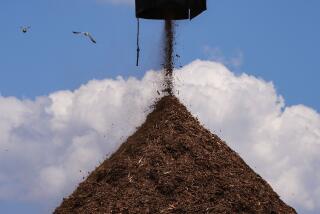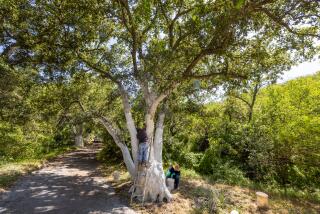Building on the trunks of ruined pines
- Share via
GRANBY, COLO. — The pine trees cradling this mountain town are dying, turned rusty red by a beetle that is destroying the Rockies’ forests.
The brittle corpses are an eyesore as well as a major fire hazard. When they collapse, they make hillsides unstable, increasing erosion and damming streams that feed into the Colorado River, which provides drinking water to seven states and Mexico.
But Randy Piper is trying to focus on the positive.
He moved here four years ago, scanned the hillsides and saw opportunity. Now he has a small showroom displaying beetle-killed pine logs that have been sculpted into doors, moldings or pieces for log cabins.
Piper emphasized the light blue streaks that run down the tawny wood, markers left by the parasites. “We’re calling it blue pine,” he said. “Sounds a lot sexier than beetle-kill.”
As lodgepole pines by the millions topple in the West, a crop of entrepreneurs is sprouting to figure out what to do with their remains. The bark-beetle plague has injected new life into struggling sawmills and timber towns. People like Piper are selling the wood as a designer material. Others are transforming the downed trees into fuel pellets that can heat buildings.
“It brings a tear to your eye if you’ve grown up here or live here,” Mark Mathis, chief executive officer of Confluence Energy in Kremmling, which is building a fuel-pellet mill, said of the beetles’ destruction. “But at least we’re trying to do something constructive.”
Tiny bark beetles used to inhabit the few forests above 10,500 feet in elevation, but in recent years they have been venturing lower.
Although beetle-killed trees helped feed fires in Southern California over the last several years, the infestation is strongest in the interior West. In Colorado last year, 650,000 acres of national forest were infected, compared with 250,000 in 2005.
One reason the insects seem to be thriving is global warming. Many of the larvae that beetles deposit in trees used to die during the depths of winter, but milder temperatures have allowed them to stay in forests year-round.
“We can’t stop the bark beetles, but we can do a lot to mitigate the impact, and part of that is producing goods for society’s benefit,” said Clint Khyle, the National Forest Service official in charge of fighting the epidemic in northern Colorado and southern Wyoming. “It’s one of the bright spots of the epidemic. There’s some real excitement in those small communities.”
In 1992, Mike Jolovich founded his salvage sawmill near Granby, a town of 1,500 on the back side of the Continental Divide. The area was settled by loggers, but lumber operations had almost vanished. And for years, Jolovich barely had enough wood to make a profit.
“Now the tables have turned,” Jolovich said. “There’s more and more material becoming available than ever before, and it’s becoming cheaper. . . . The beetles have been the catalyst.”
So many lengths of lodgepole pine are streaming into the mill that Jolovich just spent hundreds of thousands of dollars on new facilities to turn the beetle-kill into boards he ships to wood finishers, who send the product to Home Depot and other stores.
Jolovich is not celebrating the parasite’s march through his home. Sitting in the trailer that doubles as the office at their mill, he and his son spoke about how the valley surrounding Granby could easily burn with all the beetle-kill lining its hills.
“It has the potential to be devastating to everything,” Dan Jolovich said.
But the two see the epidemic as part of nature’s natural ebb and flow. In about 10 years, the beetle-killed trees will have rotted out, and the parasite will have no more food. Then new trees will repopulate the forest, they said.
That’s why Piper is pushing so hard to get his venture off the ground as soon as possible. Piper, 43, is thinking of selling his house to plow more capital into the company, which he is renaming GreenWay, to emphasize its environmental leanings.
He rode out the real estate boom in Denver, flipping homes and selling mortgages. But he burned out, and the region’s bust wiped out many of his profits. So he moved to the mountains to recover.
“I kept looking around and the trees were all dying,” Piper said. “I thought, ‘This is a terrific opportunity to make lemonade out of lemons.’ ”
Piper’s hope is to persuade home builders to use the bark-beetle pine in flooring, roof construction, trimwork and, ideally, to construct entire log homes. His showroom displays a door made of beetle pine, along with ribbons of wood that can be used for molding, fencing or decorative highlights.
Piper said that nearly all wood used to build Colorado homes is imported. Why not, he asked, take the fallen wood throughout the state and build with it? “There’s an opportunity here, hopefully, to make some money doing a good thing.”
In Kremmling, 27 miles to the northwest, Mathis is helping put the finishing touches on his company’s new wood-pellet mill -- one of four opening in the region. For years, Mathis has heated his home here with wood pellets in a special stove that emits almost no smoke. The owner of a furniture-manufacturing company that specialized in reclaimed wood products, Mathis watched the beetles devastate the thick forests, and he saw a golden opportunity.
He raised about $10 million, much of it from investors in the energy business who wanted to break into the renewable-fuels market. The plant is expected to open in February and provide up to 20 full-time jobs, as well as other work harvesting dead trees in areas at high fire risk.
Mathis fears what the dead trees could do to this tourist-dependent region should they fuel a major wildfire. And he is arranging deals with local governments to provide energy for their buildings at a price lower than natural gas. The business opportunity is exciting, he says, but there’s more to the project than profit potential.
“I haven’t seen a lot of deals in my life,” Mathis said, “that are 100% the right thing to do.”
--
More to Read
Sign up for Essential California
The most important California stories and recommendations in your inbox every morning.
You may occasionally receive promotional content from the Los Angeles Times.










